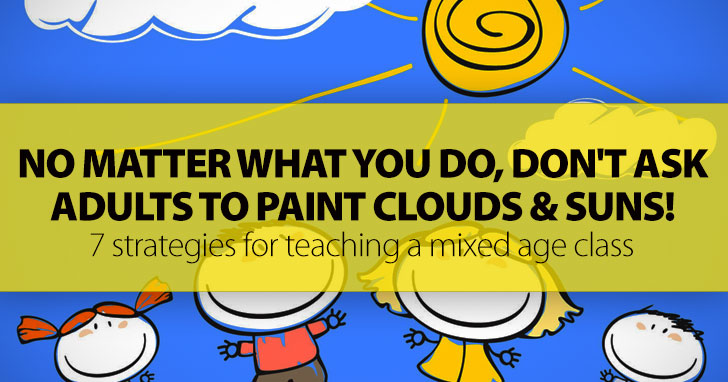
One of the greatest challenges you might face as an EFL/ESL instructor is teaching a class of all ages!
Eight year olds do not respond well to structured learning, and adults will think you are crazy if you ask them to paint clouds and suns in a kid’s experiential activity. So what can you do if you absolutely have to teach mixed age classes? Here are 7 strategies to get you through it!

Tasked With Teaching Multiple Ages At The Same Time? Don’t Panic!
-
1
Games of All Ages
Pick a game that appeals to all ages and practices English language learning.
- Scrabble
- Twister
- Pictionary
- Categories
Separate the students into groups of at least four, and mix up their ages so the competition is fair. They will all be engaged this way and have fun!
-
2
Group Challenge Scenario
Break them into diverse age groups. Give them a conversation scenario that can benefit from different aged thinking. For examples:
- They are stranded on an island and each can ask for one item to help them and the group survive. What do they select?
- They have one ingredient (like a pineapple, a banana, or a bottle of milk) and need to invent five new recipes with that food. They can add other ingredients to their recipe list, but they have to feature their particular food item.
-
3
Universal Conversation Questions
They do exist – things that we talk about from our first sentence that are still interesting as adults. For examples:
- The weather. The status of the sky is possibly the most talked about feature of life globally. Give weather prompts in a conversation class such as, “What weather scares you the most?” and “What kind of weather does your ideal day have?”
- Pets. Everyone loves their cats, dogs, fish, birds, frogs, turtles, and snakes and wants to talk about them. If they happen to scorn animals, they will want to talk about why that is.
- Family. You can ask a five year old the same questions you ask a forty year old about their family. “How many brothers and sisters do you have?” or “What do you parents do for a living?”
-
4
Me, Me, Me
We love to think and talk about ourselves from the first days we can manipulate language. Ask students to practice writing brief paragraphs about themselves. Keep questions simple, like “What did you do yesterday?” and “What do you dream of being when you are older?” Then, you can ask students to read them to the rest of the class and it will be a great listening exercise for the different ages!
-
5
Separate Them
You can always create different level activities and separate them into groups by age. If your topic is colors, ask your kids to paint pictures, your teens to write rock lyrics featuring a color, and your adults to analyze colors in a cubist painting.
-
6
Watch a Movie
Use TV or a movie that appeals to all ages! Witty Disney films are great for all ages, and you can create simple questions for students to answer as journaling exercises or grammar practice after they watch a clip. If you choose Toy Story, for example, play it in English with subtitles and ask students to write down at least 10 new adjectives. Or you can ask them to respond to questions about characters in simple past tense, such as “What did Woody wear?”
-
7
Go Somewhere
Take everyone to a local park or zoo! Bigger students can help watch littler ones, and you can give them a scavenger hunt activity where they have to work together to find certain animals, colors, plants, or other vocabulary items within the setting. Virtually any place will work for this activity if it is an option to leave the classroom.
If you are tasked with teaching multiple ages at the same time, don’t panic!
You can engage all of your students and even use the situation to your advantage to make class different and more interesting for all involved with these 7 activity ideas.
P.S. If you enjoyed this article, please help spread it by clicking one of those sharing buttons below. And if you are interested in more, you should follow our Facebook page where we share more about creative, non-boring ways to teach English.







